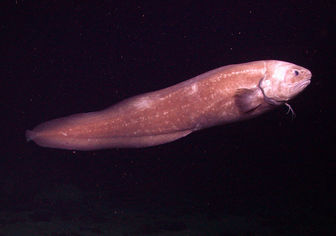Cusk-eel

The Cusk-eel lives in the reef-associated, marine, depth range 25 - 100 m environment.
The cusk-eels family (Ophidiidae) are a group of marine bony fishes in the order Ophidiiformes. The scientific name is from Greek ophis meaning "snake", and refers to their eel-like appearance. More
The pink cusk-eel, Genypterus blacodes, is a cusk eel of the genus Genypterus, found in southern Australia, Chile, Brazil, South Africa and around New Zealand except the east coast of Northland, in depths of a few metres to 1000 metres. More
C) of red cusk-eel juveniles, to serve as a reference for the fattening experiments under different thermal regimes. More
cusk-eels produce sound, and recent acoustic surveys have found large and vocal assemblages of ophidiid fishes in some areas. Sound production most likely is related to spawning behavior. FEEDING ECOLOGY AND DIET There have been no studies of the feeding habits of the band cusk-eel. More
organ below the mouth in the cusk-eels; in the true eels by contrast they are never well-developed and usually missing entirely. They are found in temperate and tropical oceans throughout the world. More
Spotted Cusk-Eel Photos and Species Information for Fish Caught in Mexico See current, on-the-spot sportfishing reports and photographs of fish caught at Mexico's top vacation spots in this week's edition of "Mexico Fishing News" and see hundreds of other fish pictures and More
Search for cusk-eel at other dictionaries: OneLook, Answers. More
anatomy, ophidiid fishes, or cusk-eels, are likely one of the chief sound producers. They have unusual sonic muscles that occur in antagonistic pairs and are typically larger in males,” said Fine, a professor in the VCU Department of Biology. More
Common names
congriperla jaspeada in Spanish (español)
Cusk-eel in English
mottled cusk-eel in English
杂色鳞鼬鳚 in Mandarin Chinese
杂色鳞鼬鳚 in Unknown
雜色鱗鼬鳚 in Mandarin Chinese
雜色鱗鼬鳚 in Unknown

Family : Ophidiidae
Genus : Lepophidium
Species : Lepophidium jeannae
Authority : Fowler, 1941
